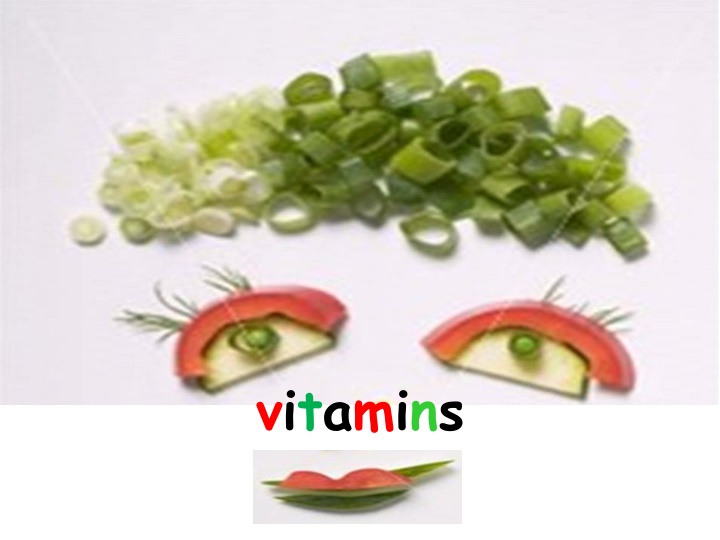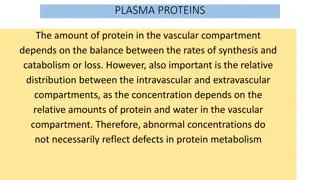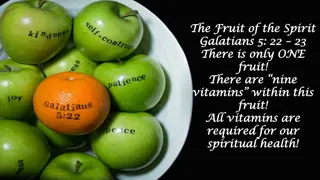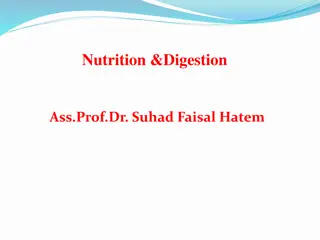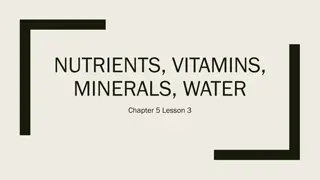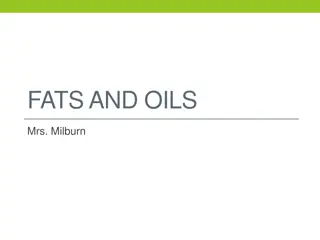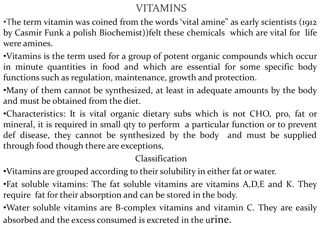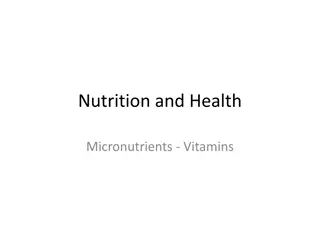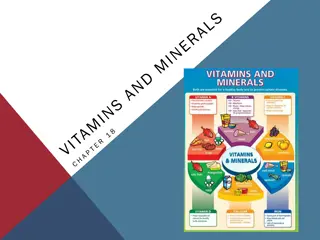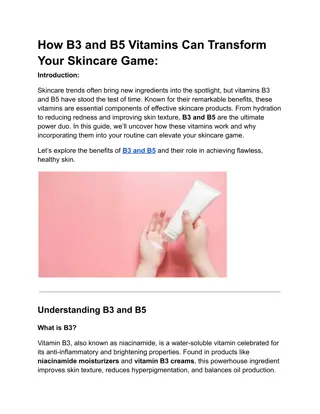Vitamins and Their Functions
Vitamins are essential organic compounds required in small amounts by organisms to carry out specific cellular functions. They act as regulators of mineral metabolism, cell growth, antioxidants, and enzyme cofactors. The term "vitamin" was coined from "vitamine" by Casimir Funk in 1912. Vitamins are classified as water-soluble and fat-soluble, each with different absorption and storage characteristics. This content covers the functions, sources, and potential deficiencies of Vitamin A.
Download Presentation

Please find below an Image/Link to download the presentation.
The content on the website is provided AS IS for your information and personal use only. It may not be sold, licensed, or shared on other websites without obtaining consent from the author.If you encounter any issues during the download, it is possible that the publisher has removed the file from their server.
You are allowed to download the files provided on this website for personal or commercial use, subject to the condition that they are used lawfully. All files are the property of their respective owners.
The content on the website is provided AS IS for your information and personal use only. It may not be sold, licensed, or shared on other websites without obtaining consent from the author.
E N D
Presentation Transcript
http://productnews.link.net/general/UNICIF/16-12-2010/flu.jpghttp://productnews.link.net/general/UNICIF/16-12-2010/flu.jpg A vitamin is an organic compound required as a nutrient in tiny amounts by an organism., and must be obtained from the diet. Vitamins are required to perform specific cellular functions.
Vitamins functions. Some regulators of mineral metabolism (e.g., vitamin D), or regulators of cell and tissue growth and differentiation (e.g., some forms of vitaminA). Others function as antioxidants (e.g., vitamin E and sometimes vitamin C) The largest number of vitamins (e.g., B complex vitamins) function as precursors for enzyme cofactors, that help enzymes in their work as catalysts in metabolism have diverse biochemical have hormone-like functions as http://productnews.link.net/general/Women/03-06-2012/fruits650.jpg
The term vitamin was derived from "vitamine," a combination word made up by Polish scientist Casimir Funk from vital and amine, meaning amine of life, because it was suggested in 1912 micronutrient food factors that prevent beriberi and perhaps other similar dietary-deficiency diseases might be chemical amines. This proved incorrect for the micronutrient class, and the word was shortened to vitamin. that the organic
Water-soluble vitamins dissolve easily in water and, in general, are readily excreted from the body. Because they are not readily stored, consistent daily intake is important. Many types of water- soluble vitamins are synthesized by bacteria. Fat-soluble vitamins are absorbed through the intestinal tract with the help of lipids (fats). Because they are more likely to accumulate in the body, they are more likely to lead to hypervitaminosis than are water-soluble vitamins
Vitamin A (retinol) Overconsumption Source Vitamin A: liver, vitamin A fortified milk and dairy products, butter, whole milk, cheese, egg yolk. ProvitaminA: carrots, leafy green vegetables, sweet potatoes, pumpkins, winter squash, apricots, cantaloupe. Physiological Functions Helps to form skin and mucous membranes and keep them healthy, thus increasing resistance to infections; essential for night vision; promotes bones and tooth development. Beta carotene is an antioxidant and may protect against cancer. Deficiency Mild: night blindness, diarrhea, intestinal infections, impaired vision. Severe: inflammation of eyes, keratinization of skin and eyes. Mild: nausea, irritability, blurred vision. Severe: growth retardation, enlargement of liver and spleen, loss of hair, bone pain, increased pressure in skull, skin changes
Vitamin D Overconsumption Source Physiological Functions Deficiency Severe: Rickets in children; osteomalacia in adults. Vitamin D- fortified dairy products, fortified margarine, fish oils, egg yolk. Synthesize d by sunlight action on skin.. Promotes hardening of bones and teeth, increases the absorption of calcium.. Mild: nausea, weight loss, irritability. Severe: mental and physical growth retardation, kidney damage, movement of calcium from bones into soft tissues.
File:Salade de jambon cru et saumon fume.jpg Fatty fish such as salmon are dietary sources of vitamin D
Vitamin E Deficiency Overconsumption Source Physiological Functions Nontoxic under normal conditions. Severe: nausea, digestive tract disorders Sensitivity of erythrocytes to peroxide, and the appearance of abnormal cellular membranes. Vegetable oil, margarine, butter, shortening, green and leafy vegetables, wheat germ, whole grain products, nuts, egg yolk, liver. Protects vitamins A and C and fatty acids; prevents damage to cell membranes. Antioxidant.
Vitamin K Overconsumption Source Physiological Functions Helps blood to clot. Deficiency Dark green leafy vegetables, liver; also made by bacteria in the intestine. Excessive bleeding. Nontoxic under normal conditions. None reported.
Water soluble vitamin Folic acid Cobalamin (vitamin B12) Ascorbic acid (vitamin C) Pyridoxine (vitamin B6) Thiamine (Vitamin B1) Niacin (vitamin B3) Riboflavin (vitamin B2) Biotin Pantothenic acid
Vitamin C (ascorbic acid) Overconsumption symptoms Stability in foods Common food sources Major functions Deficiency symptoms A deficiency of ascorbic acid result in: scurvy, a disease characterized by sore, spongy gums loose teeth fragile blood vessels swollen joints anemia . Citrus fruits, broccoli, strawberries, melon, green pepper, tomatoes, dark green vegetables, potatoes. Formation of collagen (a component of tissues), helps hold them together; wound healing; maintaining blood vessels, bones, teeth; absorption of iron, calcium, folacin; production of brain hormones, immune factors; antioxidant. Nontoxic under normal conditions; rebound scurvy when high doses discontinued; diarrhea, bloating, cramps; increased incidence of kidney stones Most unstable under heat, drying, storage; very soluble in water, leaches out of some vegetables during cooking; alkalinity (baking soda) destroys vitamin C.
http://upload.wikimedia.org/wikipedia/commons/thumb/e/e7/L-Ascorbic_acid.svg/200px-L-Ascorbic_acid.svg.pnghttp://upload.wikimedia.org/wikipedia/commons/thumb/e/e7/L-Ascorbic_acid.svg/200px-L-Ascorbic_acid.svg.png http://upload.wikimedia.org/wikipedia/commons/thumb/c/ca/Ascorbic-acid-from-xtal-1997-3D-balls.png/200px-Ascorbic-acid-from-xtal-1997-3D-balls.png
Thiamin (vitamin B1) Overconsumption symptoms Stability in foods Common food sources Major functions Deficiency symptoms Beriberi is a neurological disease. Beriberi is characterized by Dry skin Irritability Disorderly thinking Progressive paralysis . Pork, liver, whole grains, enriched grain products, peas, meat, legumes. Helps release energy from foods; promotes normal appetite; important in function of nervous system. None known. Losses depend on cooking method, length, alkalinity of cooking medium; destroyed by sulfite used to treat dried fruits such as apricots; dissolves in cooking water.
Riboflavin (vitamin B2) Over consumption symptoms None known. Stability in foods Common food sources Major functions Deficiency symptoms Liver, milk, dark green vegetables, whole and enriched grain products, eggs. Helps release energy from foods; promotes good vision, healthy Cracks at corners of mouth; dermatitis around nose and lips; eyes sensitive to light. Sensitive to light; unstable in alkaline solutions Flavin ononucleotide (FMN) and flavin adenine dinucleotide (FAD) function as coenzymes for a wide variety of oxidative enzymes and remain bound to the enzymes during the oxidation- reduction reactions. skin.
Niacin (nicotinamide, nicotinic acid, vitamin B3) Stability in foods Common food sources Major functions Deficiency symptoms Over consumptio n symptoms pellagra, a disease involving the skin, gastrointestinal (GI) tract, and CNS. The symptoms of pellagra progress through the three Ds: dermatitis, diarrhea, dementia, and, if untreated, death. Liver, fish, poultry, meat, peanuts, whole and enriched grain products Energy production from foods; aids digestion, promotes normal appetite; promotes healthy skin, nerves. Niacin is a precursor to NAD+/NADH and NADP+/NADPH, which play essential metabolic roles in living cells. Niacin is involved in both DNA repair, and the production of steroid hormones in the adrenal gland. Abnormal liver function; cramps; nausea; irritability
File:Pellagra NIH.jpg A man with pellagra, which is caused by a chronic lack of vitamin B3in the diet
Vitamin B6(pyridoxine, pyridoxal, pyridoxamine) Overconsumption symptoms Stability in foods Common food sources Major functions Deficiency symptoms Pork, meats, whole grains and cereals, legumes, green, leafy vegetables. the metabolically active form of vitamin B6, is involved in many aspects of macronutrient metabolism, neurotransmitter synthesis, histamine synthesis, hemoglobin synthesis and function and gene expression. Pyridoxal phosphate generally serves as a coenzyme for many reactions and can help facilitate decarboxylation, transamination, racemization, elimination, replacement and beta- group interconversion reactions. Skin disorders, dermatitis, cracks at corners of mouth; irritability; anemia; kidney stones; nausea; smooth tongue None known. Considerable losses during cooking. dietary deficiencies in pyridoxine are rare but have been observed in newborn infants fed formulas low in vitamin B6 in women taking oral contraceptive in alcoholics. .
Folacin (folic acid) Stability in foods Common food sources Major functions Deficiency symptoms Over consumption symptoms May mask vitamin B12 deficiency (pernicious anemia). Inadequate serum levels of folate can be caused by increased demand for folate as in pregnancy and lactation, Poor absorption of folate caused by pathology of the small intestine. Megaloblastic anemia is a primary result of folic acid deficiency causes diminished synthesis of purines and thymidine, which leads to an inability of cells to make DNA and, therefore, they cannot divide. Neural tube defect The human body needs folate to synthesize DNA, repair DNA, and methylate DNA as well as to act as a cofactor in biological reactions involving folate. It is especially important in aiding rapid cell division and growth, such as in infancy and pregnancy, as well as in "feeding" some cancer. Liver, kidney, dark green leafy vegetables, meats, fish, whole grains, fortified grains and cereals, legumes, citrus fruits. Easily destroyed by storing, cooking and other processing
Cobalamin ,Vitamin B12 Stability in foods Common food sources Major functions Deficiency symptoms Over consumption symptoms None known. Found only in animal foods: meats, liver, kidney, fish, eggs, milk and milk products, oysters, shellfish. a key role in the normal functioning of the brain and nervous system, and for the formation of blood. It is normally involved in the metabolism of every cell of the human body, especially affecting DNA synthesis and regulation, fatty acid synthesis and energy production. Pernicious anemia, anemia; neurological disorders; degeneration of peripheral nerves that may cause numbness, tingling in fingers and toes.
Biotin Stability in foods Common food sources Major functions Deficiency symptoms Over consumption symptoms Biotin is a coenzyme in carboxylation reactions, in which it serves as a carrier of activated carbon dioxide. Liver, kidney, egg yolk, milk, most fresh vegetables, also made by intestinal bacteria Uncommon under normal circumstances; fatigue; loss of appetite, nausea, vomiting; depression; muscle pains; anemia Helps release energy from carbohydrates; aids in fat synthesis.
Pantothenic acid Over Stability in foods Common food sources Major functions Deficiency symptoms consumption symptoms Liver, kidney, meats, egg yolk, whole grains, legumes; also made by intestinal bacteria. synthesize coenzyme-A (CoA), as well as synthesize and metabolize proteins, carbohydrates, and fats. Uncommon due to availability in most foods; fatigue; nausea, abdominal cramps; difficulty sleeping. About half of pantothenic acid is lost in the milling of grains and heavily refined foods. to
What Molecules Are Involved in Chemical Communications? Two systems share major responsibility for regulating body chemistry the endocrine system and the nervous system. The endocrine system depends on hormones, chemical messengers bloodstream. The nervous system relies primarily on a much faster means of communication electrical impulses in nerve cells. But the nervous system also has its chemical neurotransmitters that carry signals from one nerve cell to another and from nerve cells to their targets, the ultimate recipients of the messages. that circulate in the messengers, the
There are three principal types of molecules for communications: Receptors are protein molecules on the surface of cells embedded in the membrane. Chemical messengers, interact with the receptors. (chemical messengers fit into the receptors sites in a manner reminiscent of the lock-and-key model) Secondary messengers in many cases carry the message from the receptor to the inside of the cell and amplify the message. also called legends,
If your house is on fire and the fire threatens your life, external signals- light, smoke, and heat register alarm at specific receptors in your eyes, nose, and skin. From there the signals are transmitted by specific compounds to nerve cells, or neurons. Nerve cells are present throughout the body and, together with the brain, constitute the nervous system. In the neurons, the signals impulses along the axons. when they reach the end of the neuron, the signals are transmitted to adjacent neurons by specific compounds called neurotransmitters. Communication between the eyes and the brain, for example, is by neural transmission. travel as electric
What Are Neurotransmitters? Communication by neurotransmitters is also called synaptic signaling. This is because the communication occurs over a juncture (a place where two cells come into very close contact) called a synapse. The cell releasing the neurotransmitter is called the presynaptic cell and concentrated in an axon terminal of a presynaptic nerve cell. The neurotransmitter binds postsynaptic cell. An example is acetylcholine released by motor neurons at the motor end plate which triggers muscle contraction. the neurotransmitter is with receptors on the
As soon as the danger signals are processed in the brain, other neurons carry messages to the muscles and to the endocrine gland, Again, neurotransmitters carry the necessary messages from the neurons to the muscle cells and the endocrine glands. The endocrine glands are stimulated, and a different chemical signal, called a Hormone
What are hormones? These chemicals endocrine glands. Hormones are secreted into the interstitial fluid but then diffuse into the blood and travel to target cells throughout the body. An example is insulin which regulates energy metabolism. are released by
The distinction between hormones and Neurotransmitters is physiological, not chemical. Whether a certain compound is considered to be a Neurotransmitters or whether it acts over a short distance A cross a synapse (2 x 10-6cm), in which case it is neurotransmitter, over a long distance (20 cm) from the secretary gland through the blood- stream to the target cell,, in which case it is a hormone. For example, epinephrine and norepinphrine are both neurotransmitter and hormones. hormone depends on
